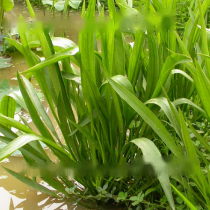
Chinese name: Narrowleaf Alisma
Latin name: Alisma canaliculatum
Family: Alismaaceae
Genus: Alisma
Distribution area: China, Japan
1. Morphological characteristics of Alisma serrata
Alismatis orientalis is a perennial herb, about 20 cm to 50 cm high , The main stem is short, but the flower stem is slender, the submerged leaves are band-rooted, stalked, the floating leaves are elliptic-lanceolate, the apex is acuminate or acuminate, the base is wedge-shaped, the margin is smooth and entire, the leaf tail is slightly curved, the midrib Obviously, the flowers are sparsely branched and bisexual, the petals are white obovate, the edges are irregular, the apex is slightly toothed, and the anthers are yellow; the pistil is composed of many carpels and is spherical. Achenes obovate-triangular. The seeds are dark purple, and the flowering and fruiting period is May-October.
2. Habits of Narrow-leaf Alisma
Narrow-leaf Alisma often grows in ponds and swamps. Sunshine, suitable temperature for growth at 16-30°C, not cold-resistant, low temperature plants are easy to freeze in hand, but rhizomes can be safely overwintered under the ice layer, moisture-tolerant, must not be short of water during the growth period, not drought-resistant, easy to die in drought state, growing environment There is no requirement, the water level height is 10 cm shallow water, it is resistant to slightly acidic to slightly alkaline fresh water with low hardness, and it is not resistant to salt and alkali.
3. The value of Alisma japonica
Alisma japonica is an extremely rare aquatic plant, and the wild population is only known to be distributed in the northern mountainous areas. Its value lies in ornamental and medicinal use, and the plants can be used as ornamental flowers. For medicinal purposes, the plant is harvested and sun-dried, and the whole plant can be used as medicine. The plant taste is light and slightly acrid, and has the effect of clearing heat and infiltrating dampness. It can be used for skin herpes, urination, edema, and snake bites For adjuvant treatment of other diseases, it is generally taken orally compared with other pharmacology, whichever is taken as a decoction.
Guess you like it
Duckweed | Cattail | Cigu | White grass| Yellow calamus|Water bamboo leaves|
Dai|Da Ping| Black algae| | Wildflower | Wildflower | Kidney fern | Ficus lobularis | Pteridophyte|
Mosaic vine | Chestnut fern | Mosaic Reed Bamboo | Aspergillus | Pond Snake | Sleeping Vegetable | Wild Lily |
Black Triangle | water poppy | small floating lotus | jade cicada flower | jade tape grass |
![[Dog Training 5] The training method of pet dog dining etiquette](/static/img/12192/12192_1.jpg)




